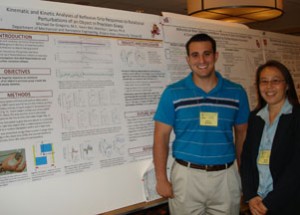By Kevin Gray
When Mike De Gregorio ’05 wakes up each morning, his mind is focused on finding ways to improve the sensitivity of a prosthetic hand. He wants to uncover the mechanism that will make the hand respond as if it were integrated with the human body’s signaling system.

Mike De Gregorio '05 with his advisor, Veronica J. Santos, Ph.D.
“I’m trying to characterize human hand reflexive responses to put those reactionary forces into prosthetic or robotic hands so they behave more human-like and reduce the burden of having to connect directly to the nervous system,” explains De Gregorio, who grew up in Ridgewood, N.J., and is working on his Ph.D. in mechanical engineering at Arizona State University. “It’s like putting in pre-programmed reflexive responses so the hand knows how to react.”
For example, if a woman is holding a glass and somebody bumps into her, she knows without thinking to move the glass back into the position it was in.
“We’re trying to get that kind of response from a robotic hand so that it doesn’t drop objects,” De Gregorio says. “This mimics what’s known as a spinal reflex, which is a reflex that doesn’t go all the way up to the brain, but goes to the spinal cord and comes back.”
An example of a spinal reflex is touching a stove and pulling your hand away before you feel that it is hot. Harnessing this type of reflex is particularly challenging because De Gregorio says that no one has found an effective way to connect neurons to wires.
“There’s no real good interface for it,” he notes. “Researchers have done work with surface electromyography where the nerves from the stump of somebody’s extricated arm are redirected into the chest. The researchers were able to connect the electrodes so they read the signals to those nerves and the patient could control the hand using the chest muscles. But the real challenge is bridging the gap between human and machine, being able to place material inside the body that it won’t reject.”
Another main challenge is getting tactile feedback from a hand to a human so that the patient can actually feel what their artificial hand is grasping. The size and weight of any prospective device is also a concern. As De Gregorio points out, the device needs to be small and light enough so that people will actually use it.
“If it is uncomfortable or super heavy, people will discard it,” he says. “This is especially true with children. If you give them a prosthetic device, they tend to take it off because it inhibits the way that they want to move freely. They will figure out ways to get around using it and live their life without the device.”
After graduating from Lafayette, De Gregorio worked at Picatinny Arsenal, near Palmer Heights, Pa., designing fuzes for mortar shells. During that time, he earned his master’s degree from Stevens Institute of Technology.
DeGregorio says his academic experience at Lafayette gave him a strong foundation for his current research.
“By being in small classes, I got to know and interact with the professors and my fellow students, so it was kind of like being in a lab,” says DeGregorio. “There was a free-flowing sharing of ideas. Things just seemed to click. The process was very conducive to learning and trying new things. It’s similar to my experience with research and graduate work where I am now.”

1 Comment
Comments are closed.